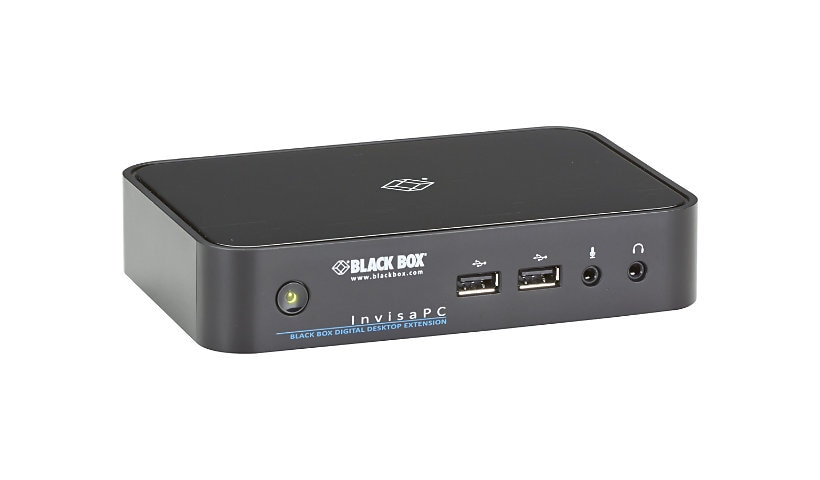
Know your gear
IP-based LAN/WAN solution enables point-to-point KVM extention or managed matrix switching system Extremely low bandwidth requirements with maximum 35 Mbps for 1080p motion picture resolution. Enables soft migration from desktop computing to virtual computing without sacrificing performance. Remote Desktop Protocol (RDP 7.1 and RDP 8 or Remote FX) delivers seamless rich media, USB redirection, and enhanced security and compliance. Integrates with Microsoft MS Server 2008 R2 SP1 and Microsoft Hyper-V Server 2008 R2 SPJ for RDP 7.1 Remote FX and Server 2012. Maximum resolution up to 1920 x 1200. Compact fanless design improves ergonomics at the users' desks. Traditional point-to-point extension over IP. With the InvisaPC solution, computers are removed from the desktop and are relocated within a secure, climate-controlled equipment room, and connected to an InvisaPC transmitter. Each user has his/her own keyboard, monitor, mouse, and peripheral setup connected to an InvisaPC receiver. The receiver delivers a high performance, real-time experience, just like running any application on a local CPU without any performance issues. The clients and the back-racked servers are connected via standard LAN or WAN infrastructure. The bandwidth requirements of the system are very low. For example, with the InvisaPC, transmitting a 1080p movie only requires 35 Mbps bandwidth and, it can use as low as a few Kbps when no activity is present. The low bandwidth requirements enable extension over the Internet with very low latency and sharing over corporate networks. Connectivity to virtual machines. The InvisaPC bridges the gap between IP-based KVM extension and switching applications and access to virtual machines. Use an InvisaPC receiver as a direct portal to virtual machines, especially Microsoft RDP 7.1 and RDP 8, to redirect digital video, USB keyboard and mouse, audio and vUSB to distant users over IP. The InvisaPC requires a host server with an operating system and associated Client Access Licenses (CALs). However, the InvisaPC doesn't require any drivers or software to be installed on computers. This hardware-based solution is plug-and-play, directly connecting to the network interface right out of the box. Flexible management. Connected to a virtual machine, one InvisaPC receiver can support up to 32 RDP, RDP 7.1/8 targets. The same receiver can also be connected with up to a total of 32 InvisaPC transmitters/servers. That way each InvisaPC receiver supports switching between a total of 32 soft and hard targets. The setting can be copied from one receiver to another to simplify setup, while user profiles may be configured on the receiver to restrict targets. Multiple receivers may be used to create a matrix switch via the network, too, without any management requirements. Adapts to growing needs. InvisaPC can easily be adapted to meet your requirements. Start with a small switching system that enables one user access to different computers and virtual machines. Gradually, the system can be expanded into a switching matrix. Future management software will also enable larger switching matrices, as well as integration into existing network authentication systems such as LDAP or Active Directory. For managed matrix solutions, use the InvisaPC manager and licenses (DTX1032-R) Flexible remote access ensures a convenient working environment. The clients operate extremely quietly-no fan noise to distract users from their work. The power consumption is about 3 watts per unit which, compared to a desktop PC, is 100 times more energy efficient. The InvisaPC client, with its space-saving design, can even be mounted behind the monitor. Moving to cloud computing with a zero client device like the InvisaPC enables IT managers to make their department more flexible and responsive. Soft migration from real to virtual machines. The InvisaPC solution provides the ability of a smooth migration from real desktops towards a virtual server landscape. The system provides integrated support for back-racked PCs and virtual desktops. In particular, the design addresses applications with a mix of both worlds-without changing the front end for the user. Desktop virtualization is deployed through a PC or server that hosts multiple virtual desktops. The workstations can be running Mac, Linux, or Microsoft operating systems using an InvisaPC transmitter. Using an InvisaPC transmitter, the system supports digital video, analog audio, and USB peripheral extension across IP networks. It is standards-based, so there are no upgrades to equipment, software licensing, or remote access-plus, no time-consuming IT visits. Real cost savings.
